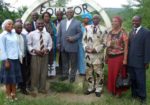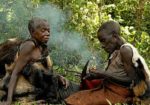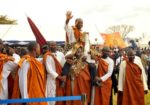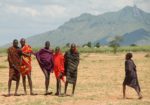Also known as the Banya Rwenzururu (The people of Rwenzururu)
The Bakonjo are found in the District of Kasese. They are the most numerous of the Rwenzori peoples, being more than the Bamba or the Bambuti. Physically they are generally short and stout.
The Bakonjo-Bamba(Bakonzo – Bantu) are small people, short and dark skinned. These form the original population of the mountainous areas and forests. Their natural surrounding gave them a rich variation in small percussion instruments, wooden horns and other small portable instruments and simple dances. The musical point of view of the bushmen had a significant influence on the general population of Uganda.
The Bakonjo-bamba who are rather dark-skinned (negroid) believe in super-human powers; their gods are called Kalisa and Nyabarika. Kalisa was shown as a monster, with only one arm, one eye, one leg, one ear, the half of a nose and only the half of a body. One half of his body was like a man.
Nyabarika was the strongest spiritual power, the ruler over life and death, companion during the hunt, etc. Shrines in the form of little huts were erected for these gods, and they were given sacrifices in the form of food.
These mountain people were excellent hunters; they hunted alone as trappers or in groups. They also used dogs for hunting. The hunter played an important role within the community. The people communicated while hunting or within the family by means of quiet whistling (a form of signal).
These are the people who inhabit the villages and farms immediately along the Uganda Rwenzori front hills. Bakonjo are commonly shortened to Konzo. In Uganda the Bakonzo are an important ethnic group of about 30’000 people, and in Congo they number more and are known as Banande.
They all belong to the Bayira, a Bantu speaking group. Like mountain people all around the world, they are industrious and self-reliant, able to pull back into the fastness of their hills in times of turmoil in the plains, which has rewarded them with a social stability rar in Uganda and Congo over the last decades.
The Bakonzo bear themselves with great dignity, are conscientious about education and that wonderful core spirit of conservative African values and modest manners. They are relaxed and open. Humour is plentiful, and a good joke can last for weeks. The Bakonjo-Bamba homestead usually consists of only one or two rectangular houses and a few small store huts, widely scattered and patched on the ridges of the foothills.
The houses are made of a double layer of plaited bamboo filled with clay and roofed with grass or banana thatch, although now more frequently with the ubiquitous African corrugated iron roof. Coffee (more recently some people grow cocoa) has been the main cash crop in the foothills.
On the plains it is cotton. With an expanding population, recent economic policies favouring stability have taken hold, and farms are being pushed further and higher into the mountain foothills, with the increasing potential for erosion and environmental damage caused by people’s pressure on the land. The Bakonjo-Bamba usually marry early, the girls at about 13 or 14.
What are their origins
Legend has it that the Bakonjo once lived on Mount Elgon in eastern Uganda and that during the Kintu migration, the Bakonjo came with Kintu and other peoples to Buganda.
However, rather than settle in Buganda, the Bakonjo decided to continue and settle in the western highland s of Mount Rwenzori which has a climate similar to that of Mount Elgon where they had originally lived. This is said to have been around A.D 1300.
Another tradition asserts that the Bakonjo have lived on Mount Rwenzori from time immemorial and that they have no foreign place of origin.
This tradition asserts that the ancestor of the Bakonjo emerged from the caves of Mt.Rwenzori and produced the rest of the Bakonjo. This tradition however is too simplistic to be generally accepted.
Their traditional marriage
Marriage among the Bakonjo-Bamba was a matter of great social concern.
It was usual for families to book spouses early in life. Often the booking would be done on the day the boy was initiated.
No marriage could be socially recognized unless bride wealth obligations had been settled. The bride wealth was normally paid in form of goats. The number of goats was determined by the economic status of the families concerned.
In addition to the number of goats, a digging stick and an animal skin had to be included. The digging stick would replace the girl’s lost labour and the skin would replace one used by the girl when young.
In modern times, a hoe and a blanket have replaced the digging stick and the skin. Divorce was rare but in the event of it, all the goats given as bride wealth would be given back.
All un married girls were supposed to be virgins. If a girl conceived before marriage, she would be executed.
The Bakonjo-bamba traditional initiation
The Bakonjo share some elements of culture with the Bamba. One such element was the initiation. The purpose of initiation was to transform the initiates from childhood to adulthood.
Therefore all the male children, before or after reaching puberty, had to undergo circumcision. This was conducted jointly by the Bakonjo and the Bamba.
The ceremony would normally begin in Bwamba and then end in Bukonjo. The initiation ceremony was conducted after long intervals, often fifteen to seventeen years. It involved all male children from the age of three years.
The traditional religion of bakonjo-bamba
The Bakonjo believed in two supreme beings; Kalisa and Nyabarika. kalisa was viewed as a monster with one arm, one eye, one leg, one ear, half nose and half for the rest of the body.
Kalisa was a half man. The exact structure of Nyabarika is not known. He is believed to be the most powerful spiritual being. He had the power to heal, kill, haunt, provide fertility or cause barrenness and, indeed, make hunting expeditions successful or otherwise.
Therefore, Nyabarika had to be pleased.
Kalisa was regarded as being very important mainly with respect to hunting.
Since hunting was a cherished occupation among the Bakonjo, one can tell the power and importance of Kalisa too.On the southern and eastern slopes of Rwenzori Mountain, the Bakonjo used to construct shrines dedicated to Kalisa and Nyabarika.
Such shrines would be made of Bamboo sheaths. They were too small for a man to enter. They are said to have been numerous in the Bamboo zones of the Nyamagasani and Nyamwamba rivers.
Traditional economy
The Bakonjo are agriculturalists. They grow mainly matoke, yams, potatoes, cassava and beans. At a later time, they took up coffee and cotton growing. In addition, they rear goats, sheep and fowls. Production was initially subsistence and they supplemented their produce by hunting and fishing on Lakes Edward and George.















